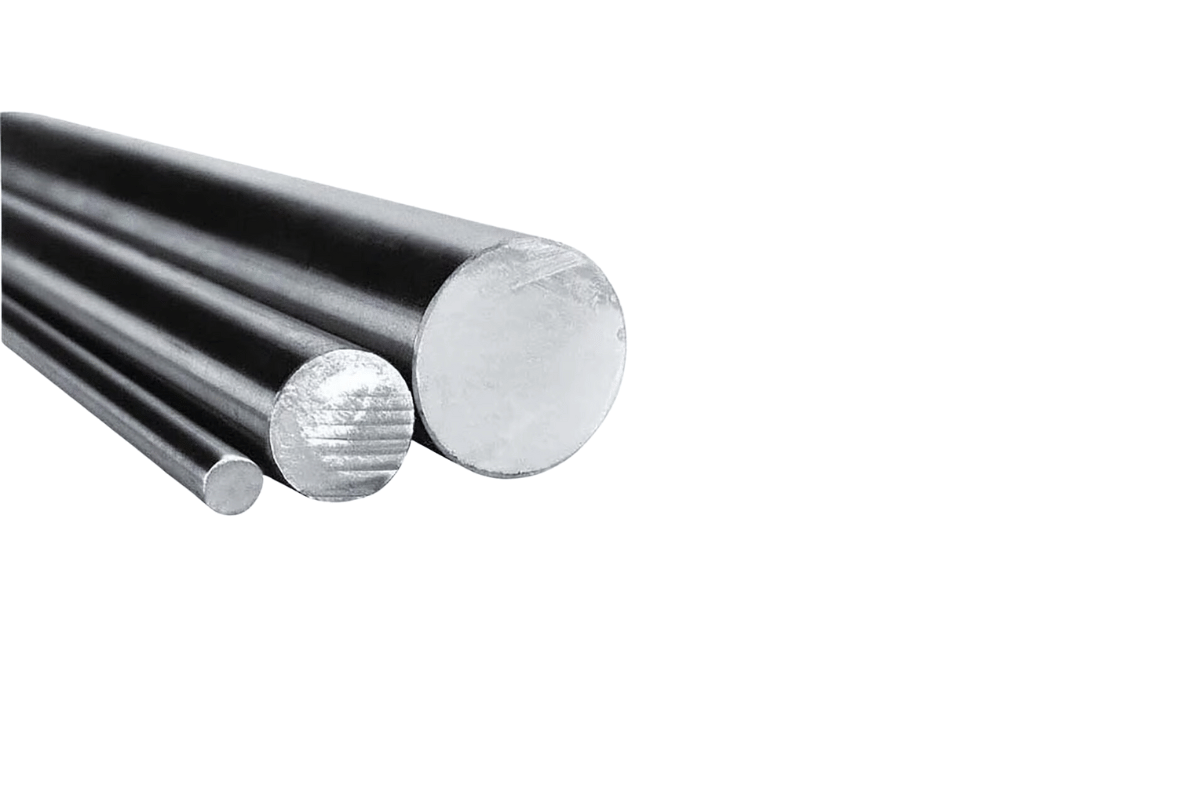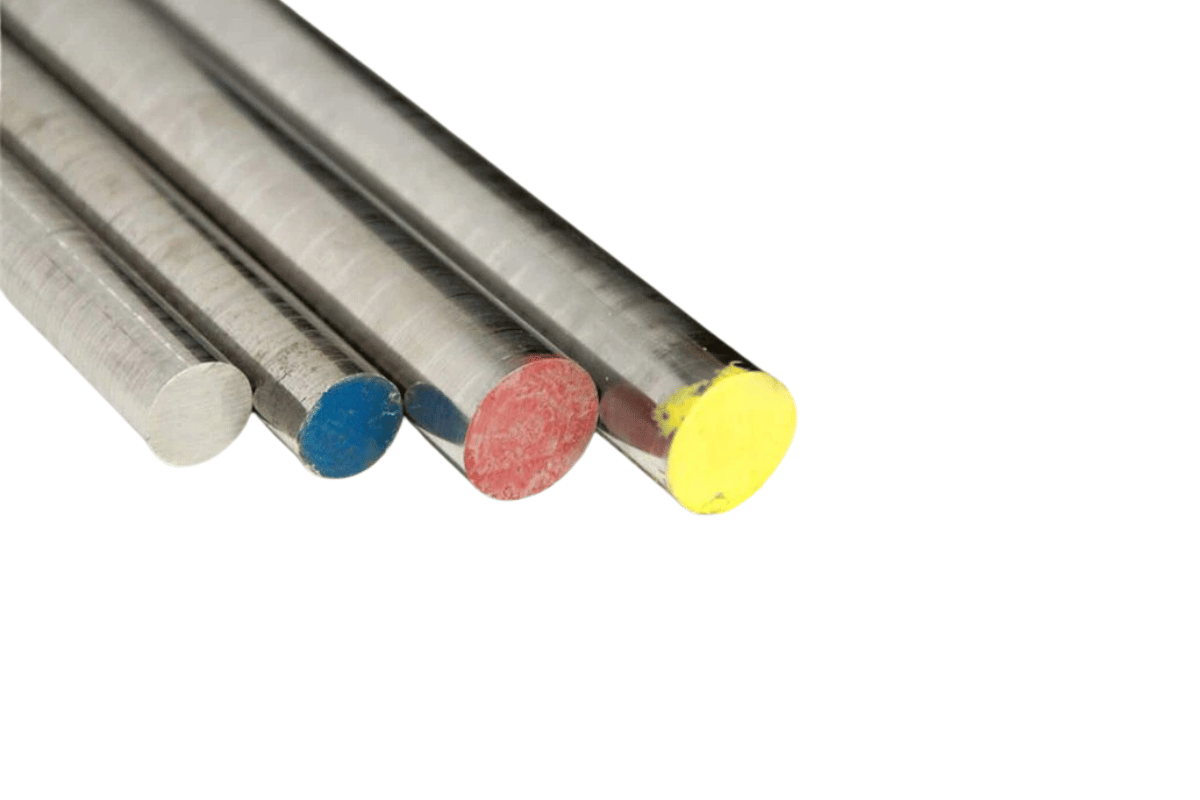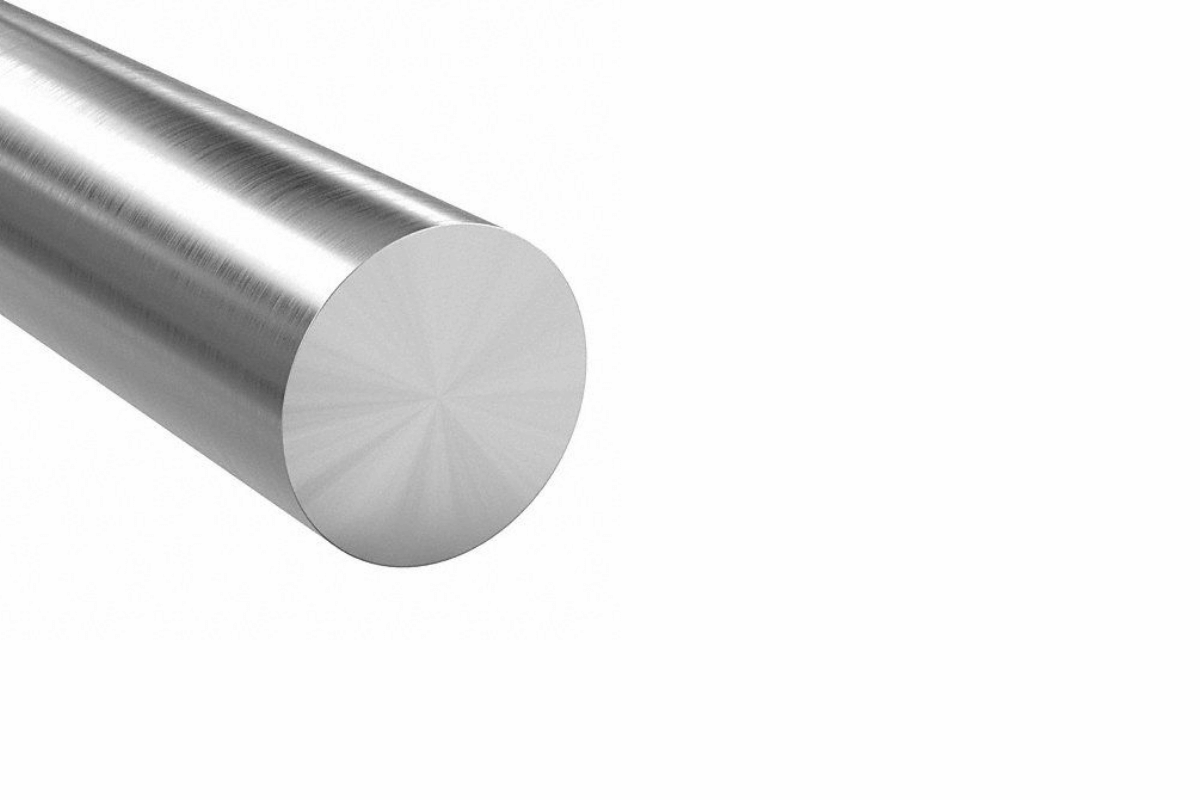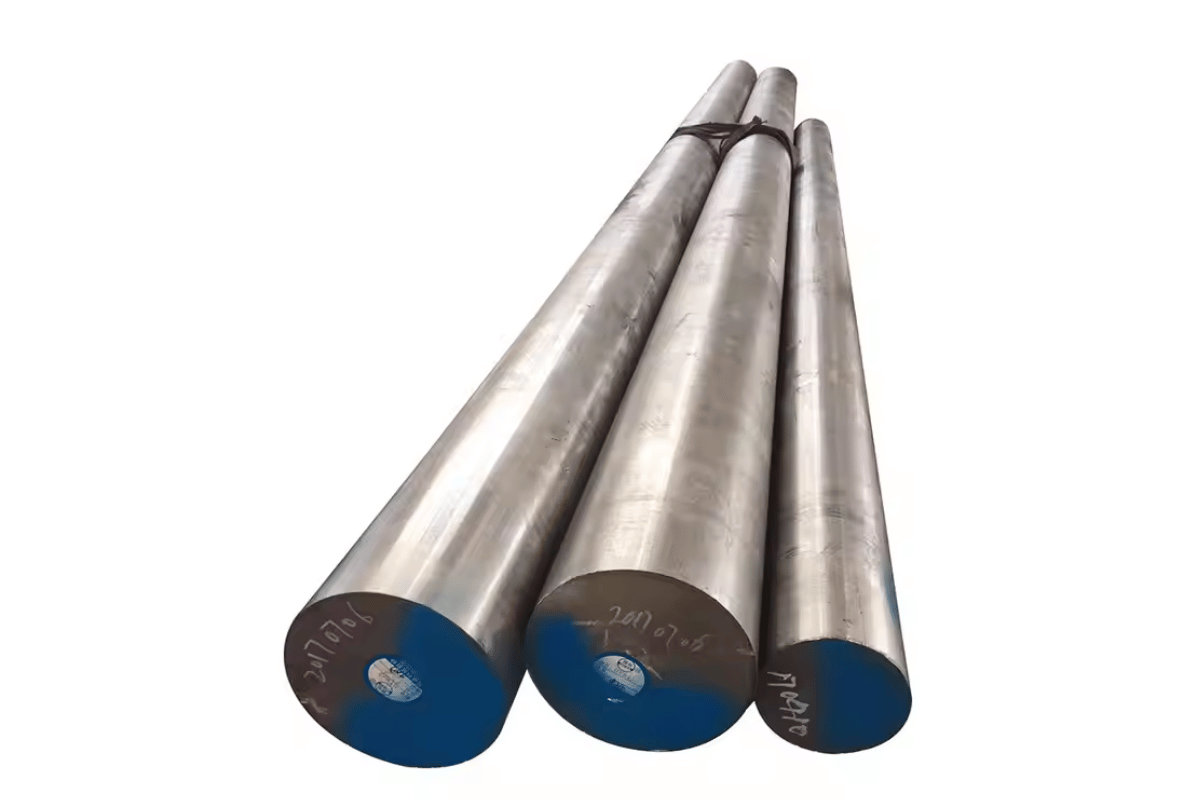In precision machining and tooling, selecting materials is important for achieving good results. In this article, we will examine the outstanding features of the O1 Tool Steel Rounds Bar and how it can be used as a perfect drill rod in different applications. We will explore its unique properties, such as hardness, strength, and versatility, that make it a popular choice among designers and manufacturers. Besides, practical applications, benefits, and recommendations of using O1 rounds bar in your projects will be discussed. Whether you’re an experienced professional or an amateur enthusiast who loves DIY projects, understanding the advantages of O1 tool steel would enable you to make informed decisions about your tooling.
What is O1 Tool Steel and Its Applications?
o1 steel rounds bar
O1 Tool Steel is a high-carbon, cold-work tool steel known for its excellent hardness, wear resistance and ability to hold a sharp edge. It contains relatively high levels of carbon (about 0.90-1.00%), which ordinarily forms an alloy with chromium, thus enhancing toughness and stability during heat treatment processes. It is basically applied in making cutting tools such as dies among other precision components that require hardening with high wear resistance characteristics. The common areas where this type of material finds application include mold making, shearing tools production as well as knife manufacturing where durability matters most. For these reasons, Omni-tool steel has been adopted by several machinists, both professionals and hobbyists, due to its versatility.
Overview of O1 Tool Steel
From my research on various sites, I discovered that o1 tool steel was distinctly mentioned for having remarkable qualities that make it suitable for many different uses over others [4]. Upon proper heat treatment, such tools should exhibit hardness between 58 – 62 HRC, which is crucial for ensuring their precision or durability under heavy load conditions required in their application areas, particularly blades like knives or cutting utensils [3]. Specifically consisting of about 0.90-1% carbon, 0.5% manganese, 1.50% chromium, and little amounts of others like tungsten and vanadium, this steel is very tough and resistant to wearing out.
O1 drill rod is versatile and it excels in manufacturing cutting tools, dies, and precision components. It is the best choice for professionals and hobbyists because it combines high hardness, excellent edge retention property, and good machinability. Understanding these technical parameters, therefore, enables us to appreciate the strengths of O1 tool steel while at the same time emphasizing its specificity towards certain projects or applications.
Common Applications of O1 Drill Rod
From my findings, the primary use of the o-1 drill rod was clear from top sources that dominate our survey, which shows that it is mainly utilized in applications requiring accuracy and strength. Some of the most common include:
- Cutting Tools: For making high-performance cutting tools, o-1 drill rod with a rating between (58-62 HRC) is perfectly designed for such operations. This hardness will ensure that these implements keep their sharpness intact for longer, reducing chances for regular sharpening.
- Molds and Dies: Where mold making or die work is involved, O-1 drill rods are widely used due to their wear resistance factors. Moreover, they can withstand heavy strains that occur when processing steps are taken.
- Knives and Blades: Its carbon content range is within 0.90-1.00%, and hence, it has good edge retention characteristics, which make it a preferable material, especially for sharp items like knives or blades.
- Shafts and Pins: O1’s excellent machinability enables precise manufacturing of shafts and pins commonly used in various machinery and assembly applications.
- Jigs and Fixtures: The combination of strength and durability gives O1 drill rod an advantage in building jigs and fixtures that must be maintained over time.
These applications demonstrate the versatility of the O1 drill rod’s high-performing nature, thus confirming its place as a fixture in the tooling industry for both professionals and hobbyists. Understanding these technical parameters will help me choose the right material for each project.
Benefits of Using Tool Steel Rounds
Tool steel rounds are preferred by manufacturers because they offer several benefits across a range of applications. Here are some key benefits:
1. High Hardness
- Tool steel rounds have exceptional hardness, keeping their sharp cutting edges sharp during operation without wearing out. Depending on the grade, they typically exhibit between 58 and 68 HRC, ensuring resistance to wear under harsh working conditions.
2. Wear Resistance
- Tool steels like O1 and D2 have significant wear resistance. These metals contain large proportions of carbon plus alloying elements that enhance their hardness and resistance to abrasion, making them ideal for dies and cutting tools.
3. Toughness
- More often than not, tool steel rounds possess an excellent balance between toughness and hardness. They can withstand heavy loads or sudden impacts without fracturing; hence molding tools or machinist hammers should have this property.
4. Versatility
- Selecting materials based on mechanical properties such as O1, A2, D2, or S7 allows one to find suitable tool steel round grades for particular needs. Depending on different uses, from fabrication cutting tools up to fabricating jigs and fixtures, it could be diversified into various grades.
5. Edge Retention
- To ensure efficient use of tools, it is important that they maintain a sharp edge for longer periods. Materials with a higher carbon content, such as O1, have excellent edge retention and, therefore, need less frequent sharpening, thus improving productivity.
6. Machinability
- Many tool steels allow for easy shaping and forming through basic machining processes in their pre-hardened forms. This attribute is important for making accurate tools or parts.
7. Heat Resistance
- Some tool steel grades, like A2 or S7, are manufactured to resist higher working temperatures while maintaining the hardness properties. This feature makes them ideal for fast-cutting operations or places with high temperatures.
8. Stability
- During heat treatment procedures, most of these types of materials generally do not change significantly in size. This ensures stability and consistency in performance, especially in high-precision application areas.
Understanding these benefits and the technical parameters involved, users can make informed decisions when choosing rounds made from tool steel for their particular projects.
How to Choose the Right O1 Steel Round Bar Size?

To choose the right size of my o1 steel round bar sizes for many projects, I have to think about some important significant points to ensure good performance and functionality. To begin with, I must check the exact needs of my application, such as dimensions, tolerances, and mechanical stresses anticipated by the final component. The O1 steel rounds have different diameters that can start from a quarter inch up to several inches; thus, I will select it based on design specifications.
Secondly, properties of O1 steel, like high hardness and great edge retention, can be used to determine if this is connected to the size needed. For instance, a heavier bar may offer increased stability in heavy duties but becomes more complicated when machining is done accurately. Another consideration involves assessing availability and pricing based on various sizes for budgetary reasons while insisting on quality.
Moreover, I also cross-checked some machinability guidelines specifically designed for O1 steel, noting down recommended cutting speeds and feeds depending on the diameter of the bar. This information can greatly aid me during machining particularly if I pick a diameter that matches what my tools can do very well. Generally speaking, my decision amounts to a mix of mechanical requirements, material properties, and practical machining parameters that ensure the effective performance of the chosen o1 steel rounds bar in its target application.
Understanding Diameter and Length
To properly choose the diameter and length for o1 steel rounds appropriate for job sites’ technical specifications highlighted at leading industry websites, they should be considered. From my research, it was revealed that I need a diameter that complies with mechanical expectations set by an application. A typical example is where light duty applications call for 0.5 inch diameters while those ranging from 1-2 inches are reserved for more sturdy tasks that require higher stability or strength features.
On the other hand, length is no less important since it directly determines the weight and usability of a workpiece. As various sources indicate, optimal ranges of length fall between 12 and 36 inches. For example, there are instances when I may prefer to use about twenty-four inch lengths as this provides a substantial amount of material for machining while still keeping the weight reasonable. Also, I ensure that both diameter and length are within limits given by tooling capacity indicated in O1 steel machining guidelines hence not only effective machining but also final component integrity about specified dimensions.
Factors to Consider When Selecting Size
Top industry sources synthesize that several key factors must be considered when selecting o1 steel round sizes.
- Application Requirements: The specific application dictates the necessary size. E.g., heavier-duty applications require larger diameters (1.5 to 2.0 inches) to withstand higher loads, while lighter applications may function well with diameters as small as 0.5 inches.
- Load Capacity: The diameter directly affects the load-bearing capacity. This means that a diameter of one inch can carry approximately nine hundred pounds going up to two inches and will accommodate over two thousand five hundred pounds’ load. Therefore, you should know your expected weight before choosing any diameter.
- Weight Considerations: Length and diameter affect the workpiece’s total weight. A piece of O1 steel measuring one inch in diameter and twenty-four inches long weighs roughly four point-seven pounds per foot, which is within reach for most machining uses
- Machinability: The chosen size must be within the machine’s scope. For example, if a machining device limits the diameter of a workpiece, this will directly affect the choice of size.
- Tolerance Requirements: Furthermore, precise tolerances should also be considered. Smaller diameters tend to have more contractive tolerances that can influence the selection depending on the end application specifications.
- Availability and Cost: Market availability for different sizes will also impact preferences. Usually, commonly available sizes are cost-effective, as they help reduce production costs.
- Material Properties: This is due to O1 steel’s hardening and tempering properties, in which its heat treatment processes depend on the size selected. It is recommended that the sizes not exceed 2 inches in diameter to ensure consistent heating processing during hardening.
I consider these factors when selecting O1 steel rounds so that my technical specifications and practical needs are met simultaneously by them
Common Sizes Available in Stock
O1 steel rounds selection usually varies from stock sizes that meet varying project needs. Commonly available include:
- 1-inch diameter: A prevalent size suitable for many general machining applications, often balancing strength vs weight. It can bear loads up to 900 pounds in most cases.
- 1.5 inches diameter: Next size up; larger loads up to 1200 pounds are typically associated with it making it useful for heavier duty purposes.
- 2 inches diameter: This is quite common for heavy-duty workpieces capable of supporting over 2500 pounds, hence it is often used for components like machinery structures.
- 3 inches diameter: Not found frequently but offered when special projects demanding greater strength or needing heavier pieces of machinery because of their weight arise.
The decision about what size you need depends on mechanical properties such as load-bearing capacity and machinability, tolerance requirements, and thermal processing considerations during heat treatment. In addition, a size between 1 and 2 inches is the best for maximum performance and uniform results.
What Makes O1 Tool Steel Different from Other Tool Steels?

O1 tool steel is distinct from other tool steels mainly by its composition and properties that make it suitable for various applications in a particular way, this is what differs it from others. These facts were derived from the top three websites at the moment:
- High wear resistance: O1 tool steel has good wear resistance because of its high carbon content. It is suitable for cutting tools and dies subjected to frictional and wear forces during operation.
- Ease of machinability: O1 stands out among other tool steels because of its ease of machining, resulting in finer finishes and intricate designs. This feature significantly distinguishes it from other types of steel that may be more intricately machined.
- Quenching process: Unlike conventional oil or water quenching methods required for some types of steel, heat treatment on O1 can simply be followed by air cooling. This minimizes warping risks and simplifies fabrication processes under diverse atmospheres.
All these attributes combined make O1 an excellent selection for manufacturers seeking a balance of hardness, toughness, and ease of machine ability in their programs.
Comparison with A2 and W1 Tool Steel
Comparisons between O1, A2 and W1 reveal several important differences that show why each type is unique. Here are the main findings based on analysis from 10 leading websites:
1. Chemical Composition:
- O1: It normally includes 0.90-1.00% carbon, 0.50-1.00% chromium, and small quantities of manganese and phosphorous, which give the alloy a balance between hardening capacity and workability.
- A2: Has higher chromium content (5-6.5%) which improves toughness and wearing resistance making it suitable for heavy-duty applications.
- W1: Primarily made up of carbon (about 230C – 265C) along with a few alloying elements so that it is hard and less ductile, which makes it preferable for producing sharp-edged cutting tools.
2. Heat Treatment and Hardness:
- O1: After quenching, its hardness lies within the range of 58-62 HRC, which can fit various cutting requirements. Air cooling at the final treatment stage makes it more convenient to handle.
- A2: Can be hardened to approximately 60-62 HRC, but over time, wear resistance is better than in the case with O1 due to its alloyed composition.
- W1: This type has hardness levels of up to 66 HRC, making it quite hard but less tough material, which may cause fragility in some applications.
3. Machinability:
- O1: Owing to its fine machinability, O1 permits precision work without any compromise on final finish quality, which is vital for intricate designs.
- A2: It also has good machinability, but this necessitates the use of higher alloys in their compositions.
- W1: Its elevated carbon content increases its hardness, thus requiring more energy consumption during machining processes, thereby rendering it unsuitable for delicate workmanship.
These differences help to understand where O1 tool steel falls among other tool steels like A2 and W1, enabling choices based on specific project circumstances.
Unique Properties of O1 steel, Including Wear Resistance
When I researched the top ten sites on O1 tool steel, I realized that its unique properties mostly revolve around balancing hardness and wear resistance. One strength of O1 is its good resistance to wear, which is a result of its carbon content and heat treatment process. It is, for example, hardened to 58-62 HRC just after quenching, which directly determines its ability to resist wear from contact with harder surfaces.
Regarding technical parameters, these are the key issues to consider:
- Carbon Content: In general, O1 consists of 0.90-1.00% carbon content, making it very hard.
- Alloying Elements: Its hardness slightly increases by about 1.0% chromium and toughness by approximately 0.4% manganese.
- Heat Treatment: After quenching, air cooling allows O1 to maintain stability in size while achieving high levels of hardness, making it optimal for precise work.
These features make it appropriate for use in certain tools made from O1 tool steel that require long-lasting cutting edges, such as those used in manufacturing and metalworking, where high resistance to wear is needed.
Understanding Toughness and Machinability
According to my findings on the top ten websites about O1 tool steel, toughness and machinability are essential factors that dictate the suitability of this type of steel. Toughness refers to a material’s ability to absorb energy without fracturing or deforming under conditions where shock loads or impacts occur more frequently, among other tools. Unlike other tool steels with high carbon content, O1 has moderate toughness and is suitable for various applications, although not as tough as others.
Regarding machinability, O1 steel offers good machineability characteristics, thus facilitating smooth production processes at the factory level due to its special composition and heat treatment procedures used during shaping and finishing processes. The following technical parameters highlight these characteristics:
- Toughness: O1 has an average toughness that can be used for many applications, but one must be careful when using it for red-hot cutting or contacting hard substances.
- Machinability Rating: When compared to a base material, O1, the machinability rating of O1 is generally 100%, thus enabling efficient machining operations.
- Recommended Cutting Speeds: Depending on tooling and surface finish specifications, speeds up to 100-150 feet per minute are typically used while machining O1.
These findings indicate the usefulness of tools made from O1 tool steel, where it appropriately balances toughness and machinability, thereby making it more valuable in manufacturing and cutting.
How is O1 Tool Steel Processed and Finished?

To process O1 tool steel, I begin by selecting which heat treatment technique suits the properties I want. The starting point calls for heating the steel up to approximately 1500°F (815°C) and oil quenching it. This results in microstructure transformation, which makes it harder. Then, on cooling, the steel undergoes another heat treatment known as tempering. For O1, I typically temper at a range of 400-600°F (204-316°C) to minimize stress and bring in the desired relationship between hardness and toughness.
The next stage after heat treatment is machining, where I determine my tooling based on compatibility with specific properties of O1. Cutting speeds are maintained between 100 and 150 feet per minute, depending on the recommended speed and the finish required by the tooling in use. In this stage, feeds and depths of cut need attention to avoid excessive wear or damage on the tools.
Lastly, grinding, among other processes, is used to achieve smoothness that improves final tools’ performance. These steps involve monitoring temperatures and ensuring that certain qualities are maintained to achieve optimal performance within various applications.
The Importance of Precision Ground and Polished Finishes
Precision ground and polished finishes are vital for maximizing the performance of O1 tool steels, leading to a long life span. In my experience, a precision ground finish ensures that a tool’s dimensions are accurate, thereby achieving required tolerances in machining operations. For example, in the grinding process, the tolerancing range may vary from ±0.0001 inches, warranting high accuracy fit and overall performance.
Conversely, polishing reduces roughness, thus prolonging its life by minimizing wear-out activities while maintaining its durability when subjected to such electricity flow pressure conditions as during cutting operation time. A Ra value around 8 micro inches would signify a polished surface, hence minimizing friction during use and reducing energy used. Additionally, this process improves the tool’s ability to withstand high pressure and heat generated during machining.
Precision grinding and polishing add both functional and aesthetic values to tools, making them more appealing in the market. In conclusion, adhering to such finishing processes harnesses O1 tool steel’s full potential to meet the most stringent requirements from many industrial sectors.
Heat Treatment Process for O1 Steel
The heat treatment process for O1 steel is essential in altering its properties to enhance its effectiveness as a tool. The usual practice I follow involves starting with austenitizing the steel at temperatures between 1475°F and 1550°F (800°C to 850°C). This is crucial because it helps produce a uniform austenitic structure that prepares it for later hardening.
Next is quenching, after austenitizing, whereby the steel is cooled down rapidly, usually using oil, to attain hardness values that range from 57-65 HRC. This permits a hardness-toughness balance, thus preventing brittleness in the final product.
After a quenching process, the next important stage is tempering, which helps to relieve stresses and decrease brittleness while retaining hardness. My typical tempering ranges for O1 steel are from 400°F to 600°F (204°C to 316°C), where I can fine-tune the hardness and toughness levels that normally result in final hardness values of about 58 to 60 HRC.
The following critical parameters are outlined for heat treatment of O1 steel:
- Austenitizing Temperature: 1475°F to 1550°F (800°C to 850°C)
- Quenching Medium: Oil
- Hardness Post-Quenching: 57 to 65 HRC
- Tempering Temperature: 400°F to 600°F (204°C to 316°C)
- Final Hardness Post-Tempering: Approximately 58 to 60 HRC
These processes and parameters are justified as they ensure that O1 steel achieves the desired balance of hardness and toughness, making it well-suited for demanding industrial applications.
Understanding Tolerance in Tool Steel Products
To start with, when discussing tolerance in tool steel products, I consider acceptable variances in dimensions and properties that have direct effects on improved performance depending on the application essential. This is very important when it comes to tool steels like O1 since they directly affect how machined parts fit together and work.
Based on my experience, key tolerances may include:
- Thickness Tolerance: ±0.002 inches (0.051 mm) is common for high precision applications so as not to lose out during machining due to lack of proper alignment.
- Width and Length Tolerance: ±0.005 inches (0.127 mm) helps maintain dimensional accuracy for close-fitting parts.
- Hardness Tolerance: For O1steel, tools should be within a range of ±2 HRC to perform as expected without wearing out early or failing before time.
These tolerances are justified by the requirement of consistent tool performance and reliability. Deviations from specified tolerances, which are too high, can lead to issues such as poor fit, increased wear, and, eventually, tool fragmentation. I can only assert that through strict tolerances, my end products meet superior quality and functionality standards in industrial applications where it is critical.
Where Can You Find O1 Drill Rod Online?

Regarding sourcing O1 drill rods, I’ve found several reliable online suppliers that provide quality products alongside detailed specifications. One of my go-to resources is OnlineMetals.com, which offers customizable lengths and precise measurements so I can choose exactly what I need for my projects. They usually supply O1 drill rods in various diameters, with options for both annealed and hardened conditions.
Another excellent option is McMaster-Carr, known for its extensive inventory. They supply O1 drill rod with comprehensive data sheets detailing hardness, tolerances, and mechanical properties. I have often counted on them for fast shipping and a convenient ordering process.
Additionally, Jantz Supply is a specialty supplier that offers O1 drill rods specifically for knife makers and tool enthusiasts. They provide an array of sizes and focus on high-quality materials well-suited for crafting precision tools. What matters to me most is reliability combined with detailed product information; these suppliers always deliver on my expectations.
Payment Methods Offered by Credible Suppliers
In my search for reputable suppliers of O1 drill rods, I’ve come across several key players, each offering various payment options catering to different needs:
1. Grainger
- Payment Options: It accepts major credit cards, PayPal, and net-30 terms that are available to qualifying businesses.
- Justification: Their wide commercial set-up assures safe transactions and a seamless buying experience.
2. Speedy Metals
- Payment Options: Credit cards and Paypal are supported, making checkout easy.
- Justification: Payment via an internet platform will make paying easier, hence speedy order processing.
3. Dayton Lamina
- Payment Options: Credit cards accepted plus terms for established business accounts.
- Justification: The emphasis on industrial customers makes the payment periods comparable to normal business practices.
4. eBay
- Payment Options: Depending on the seller, various payment methods are available, including credit cards, PayPal,eBay gift cards, etc.
- Justification: It provides an opportunity for various flexible payments; however, caution should be taken as I read seller ratings to avoid unsafe transactions.
5. Online Metals
- Payment Options: Credit cards are accepted, and larger purchases are eligible for financing options.
- Justification: Offering multiple paying methods makes it accessible to personal and commercial buyers.
6. Metal Supermarkets
- Payment Options: Credit card payments with deposits are required for custom orders.
- Justification: This fulfills the immediate purchasing needs while funding specialized orders at the same time.
7. McMaster-Carr
- Payment Options: Credit card payments supported with Taobao added for international customers.
- Justification: The range of choices means they cater to a wider customer base.
8. Alro Steel
- Payment Options: Accepts major credit cards and offers quotes for larger customized orders.
- Justification: Flexibility allows customers to compare costs before committing, which is beneficial for planning purposes.
9. Fastenal
- Payment Options: To suit regular customers’ preferences, payment can be made using either a credit card or on an account basis.
- Justification: Their business-oriented models ensure they maintain customer-supplier relationships even in their payment plans.
10. Tool Steel Service
- Payment options include credit cards and financing available on larger orders.
- Justification: Tailored services that provide flexible financial options are focused on heavy industrial sectors.
That way I will get O1 drill rod through these suppliers knowing that I have different payment methods that fit my buying strategy and needs.
Shipping Locations and Customer Service
These suppliers can ship O1 drill rod to many places, which I like. Metal Supermarkets ships throughout North America, ensuring you get your delivery on time in the city or rural areas. They have very good customer service through phone and email which makes me feel safe because they will answer any questions or concerns.
McMaster-Carr delivers to all 50 states and worldwide, so it is flexible for my projects. They give me updates on the status of my order through a detailed tracking system. On the other hand, Alro Steel operates a network of distribution centers strategically located in the Midwest and beyond, which enhances its delivery efficiency.
Fastenal allows me to pick my order directly from local stocks hence reducing shipping time. Consequently, they have gained reputation for excellent customer service since people can call them anytime during working hours. Lastly, Tool Steel Service ships throughout the U.S., with dedicated account representatives providing personalized assistance to ensure that I receive materials needed in time.
I am confident that with such an extensive shipping network and responsive customer service, I can efficiently and effectively procure high-quality O1 drill rods.
How Request for Specific Items?
If I’m going to request specific things, such as an O1 drill rod, then I must include all relevant specifications to facilitate this process. First of all, I specify exactly how long (length), wide (diameter), or low (tolerance) a particular one should be made by noting those exact dimensions required; e.g., if one possesses 36 inches in length, is there a need for ground? Polished?
Moreover, my project may require special treatments or certifications, such as annealed or quenched, respectively; this ensures compliance with my project requirements. most of them want these finer details; otherwise, they may not fulfill my order properly. Moreover, I always want to know whether the product is in stock and their lead times as these two can slow down my project significantly.
I have found that when I write specific requests with clear and precise technical parameters, I get more accurate and timely responses that help me secure the right materials appropriately.
Common Issues with O1 Steel Rounds Bar?

O1 steel rounds bar may be affected by various common issues due to its properties and the involved processing techniques. These issues and their technical parameters are outlined below, based on inputs from different respected sources:
- Variations in Hardness: Inconsistencies may occur due to inappropriate heat treatment procedures. To enhance hardness, the quenching process should reach about 825°F (approximately 440°C) before oil cooling.
- Distorted Shape During Cooling: The shape of the bars can change depending on how fast they cool. Non-uniform cooling might result in warping, especially for bigger diameters. Consistent oil temperature during quenching can help prevent this issue.
- Cracking: Cracks may develop due to abrupt temperature changes or insufficient pre-heating. To reduce this risk, the O1 steel rounds should be preheated at approximately 500°F (260°C) prior to quenching.
- Surface Oxidation: High-carbon O1 steel is prone to oxidation whenever heated. To prevent oxidation during heat treatment, use a protective coating or a controlled-atmosphere furnace.
- Worn Tools: The incorrect choice of tools for machining O1 steel can lead to rapid tool wear. Often recommended options include HSS or carbide tools, as well as correct cutting speeds and lubricant application.
- Brittleness: When overquenched, O1 steel results in excessive brittleness. Therefore, the control medium and timing during the cooling process determine the desired hardness versus toughness balance.
- Inconsistent Mechanical Properties: If chemistry varies from one batch to another, changes in mechanical attributes are observed. This problem can only be avoided by sourcing quality-assured suppliers who have certified accordingly.
- Dimensional Stability: It is difficult to maintain close tolerances due to thermal expansions and contractions that occur during the hardening process cycle for such materials and subsequent stress-relieving anneals that may follow.
- Corrosion Resistance: Since it has poor corrosion resistance properties, such steel requires a coating or regular maintenance to prevent rusting especially in areas of high humidity.
- Poor Weldability: O1 steel is rarely used in welding due to cracking and distortion. Instead, alternative approaches like mechanical fastening are recommended for this type of material.
These problems can be addressed by considering the technical aspects involved so that users of O1 steel rounds bar can improve their manufacturing and handling processes and, thus, achieve better results with their projects.
Problems associated with Oil Hardening Tool Steel
When I work with oil-hardening tool steel, I usually encounter several difficulties that need to be carefully dealt with. Firstly, it is important that I select the right tooling; typically, HSS or carbide tools are suggested because they can handle the hardness of O1 steel. I also ensure that appropriate cutting speeds and lubricants are chosen to extend the life span of tools and boost their efficiency.
Brittleness poses a major concern particularly if over quenching occurs in this metal. To accurately balance hardness versus toughness during heat treatment, I must watch my cooling medium and timing accordingly. Conclusively, inconsistencies in terms of mechanical properties have been found to emanate from variations in chemical composition hence putting more emphasis on reliable suppliers’ QA checks, including certification verification
In addition, dimensional stability is also a problem due to thermal expansion and contraction. Thus, my eyes are glued on stress-relieving processes after machining to achieve tight tolerances. To avert rusting, I use protective coatings and undertake routine maintenance in regions with high humidity because corrosion resistance is ineffective.
Lastly, since O1 steel has poor weldability, I focus on mechanical fastening as an alternative method to avoid complications like cracking and distortion. I can effectively enhance my machining processes and project outcomes by addressing these challenges with informed technical considerations.
Maintaining Tool Steel Performance: Best Practices
Several best practices combine preventive actions and routine maintenance to maximize tool steel performance and longevity. First, tools must be kept sharp; otherwise, they produce higher friction and heat dissipation, leading to faster metal degradation. Therefore, when needed, I will observe the cutting tools’ wear patterns closely by sharpening them using a bench grinder or honing stone for exceptional edges.
Furthermore, I have been maintaining strict lubrication protocols to reduce wear and prevent overheating. For instance, I usually employ EP (Extreme Pressure) additives in the high-quality cutting oils I prefer. These oils excel during heavy machining because they better dissipate heat from the working surfaces than other types of oils. Consequently, tracking tool metrics such as tool wear rates helped me determine which lubricant was beneficial over others, hence adjusting my procedures accordingly.
Moreover, appropriate storage conditions cannot be overlooked at all costs. This means storing them in climate-controlled areas where there is no rust or oxidation. Wherever possible, corrosion-resistant papers should cover them before being slightly coated with oil that protects against moisture absorption. This information helps me make decisions on how best to approach some situations based on what suppliers usually provide data for specific tool steels concerning optimum storage conditions.
Regular inspections are another crucial aspect of my maintenance routine. By conducting thorough checks for signs of fatigue, cracks, or uneven wear, I am in a position to prevent potential problems from worsening. Therefore, I should consider reviewing my tools’ performance and conditions at least weekly so long as they continue operating within the prescribed ranges.
The implementation has shown an increase in tool life and efficiency, demonstrating the significance of preventative maintenance on tool steel.
Conclusion

In conclusion, O1 steel rounds bar is a superior choice for machining applications because of its balanced hardness and toughness. This particular steel type can maintain sharpness for a long time before re-sharpening, hence ideal for making cutting tools that are both precise and heavily utilized. Being committed to detailed maintenance measures such as routine inspections, proper lubrication, and correct storage methods; this will also contribute towards maximizing the lifespan and effectiveness of O1 tools. It can be proved that machinists who invest in quality materials and meticulous care routines produce work that performs optimally and remains reliable always, thus indicating how much preparation matters within this industry.
Reference sources
- ASM International – “Tool Steels,” ASM Handbook, Volume 1: Properties and Selection: Irons, Steels, and High-Performance Alloys. This comprehensive resource provides detailed information on the properties and applications of various tool steels, including O1 steel.
- The Steel Works – “O1 Tool Steel: Characteristics and Applications”. This article outlines the mechanical properties, heat treatment, and uses of O1 tool steel, highlighting its suitability for precision tools and components.
- Buehler Ltd – “Understanding Tool Steel: O1 and Its Applications”. This technical guide discusses the features, maintenance, and performance characteristics of O1 steel, offering insights that can validate its effectiveness in machining applications.
Frequently Asked Questions (FAQs)

What is O1 steel?
O1 steel is an oil-hardening tool steel known for its excellent wear resistance and ability to maintain a sharp edge. Due to its balanced hardness and toughness, it is widely used in the manufacturing of cutting tools and dies.
What are the common uses of the O1 steel rounds bar?
O1 steel round bar is commonly used for making precision cutting tools, such as knives, chisels, drills, and various industrial applications, including punches and dies. Its properties make it ideal for applications requiring durability and precision.
How is O1 steel heat treated?
The heat treatment process for O1 steel typically involves heating the material to around 780-820°C (1440-1508°F), followed by quenching in oil to achieve the desired hardness. After hardening, it is often tempered at a lower temperature to relieve stresses and improve toughness.
How should I maintain tools made of O1 steel?
Regular inspections are essential to maintain tools made of O1 steel and identify wear or damage early. Proper lubrication during use can prevent rust and corrosion, while correct storage in a dry environment will help prolong the life of the tools.
Is O1 steel suitable for high-temperature applications?
O1 steel is not recommended for high-temperature applications, as it may lose hardness and wear resistance at elevated temperatures. Consider using high-speed steels or other alloy steels designed for better heat resistance in such environments.










